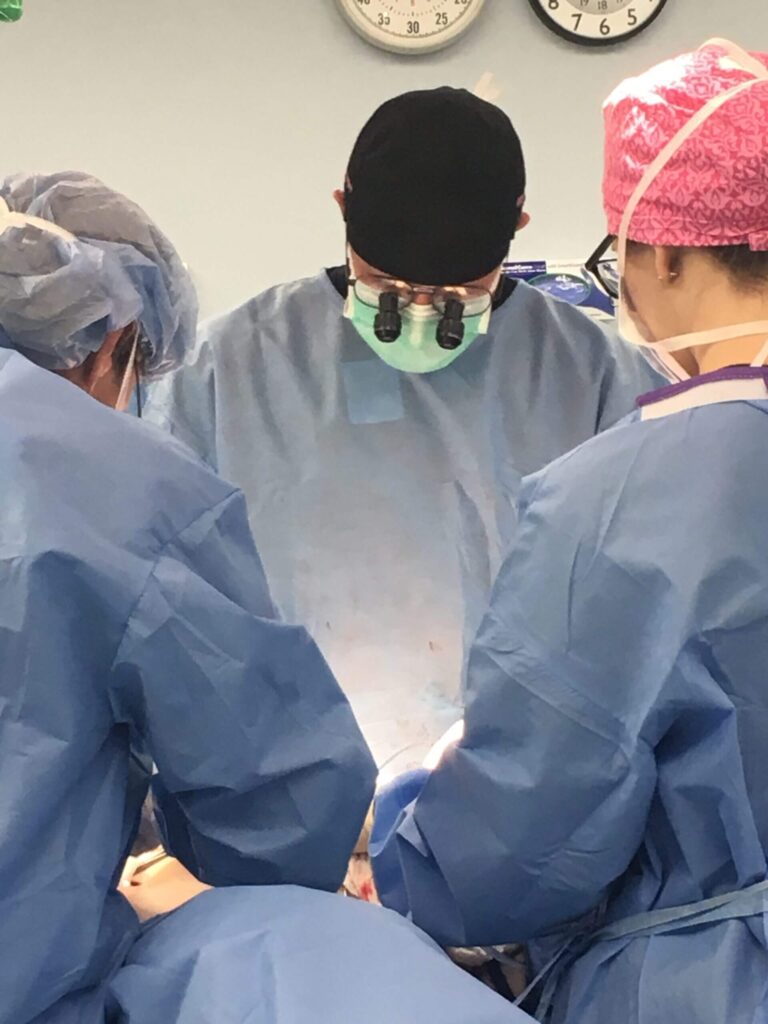Revision Breast Reconstruction Surgery
Whether a breast reconstruction is performed using an implant or the patient’s own tissue (“autologous” flap), it usually takes more than one stage for the best results. A second procedure—referred to as the “revision stage” or “stage 2″—is designed to fine-tune the reconstructed breast(s) in order to improve the overall cosmetic appearance.
Stage 2 breast reconstruction is typically performed about 3 months after the initial reconstruction as a day surgery (outpatient).
For implant-based reconstructions, stage 2 usually involves exchange of the tissue expander for the permanent implant, and fat grafting to improve the soft tissue contour and “padding” over the implant. Direct-to-implant (“one-stage”) reconstructions can also require revision surgery, usually fat grafting. For autologous (flap) breast reconstruction, revision surgery usually involves scar revisions, fat grafting, and shaping of the reconstructed breast(s).
If the reconstruction was performed as a unilateral (one-sided) procedure, stage 2 usually also involves symmetry surgery on the other breast to match the breasts as closely as possible if this was not performed at the first surgery.
Revision surgery is also an option for patients unhappy with the results of reconstruction performed elsewhere.
The Exact Details Of The Revision Surgery You Need Will Depend On The Type Of Breast Reconstruction You Had Initially.
Autologous Tissue Breast (Flap) Reconstruction
Flap revision involves shaping the breast(s) and making them as symmetric as possible in terms of size and shape. Fat grafting can be used to address contour irregularities and size discrepancies. The donor site scar (the scar from where the tissue was taken) is also revised to minimize its appearance as much as possible and improve the contour of the donor site. Nipple reconstruction is also performed at this stage whenever possible if the patient did not have a nipple-sparing mastectomy.
2-Stage Implant Breast Reconstruction
Once tissue expanders are adequately filled they are exchanged for permanent breast implants. This is usually done about 3 months after the initial surgery. Two types of breast implants are available to patients: Saline and Silicone. We advise that you speak with your plastic surgeon to decide which implant is best for you. The implant pocket(s) can be adjusted if needed to improve the overall breast shape and symmetry. Fat grafting can also be performed at this stage to improve the overall contour and make the results as natural as possible.

Expected Outcomes
Direct-to-Implant Breast Reconstruction
Direct to Implant breast reconstruction involves placing the final breast implant at the same time as the mastectomy. Unlike traditional 2-stage implant reconstruction using expanders, the reconstruction is completed in one surgery. The direct-to-implant procedure is also sometimes referred to as “single-stage” or “one-step” breast reconstruction. These terms can be misleading as a revision procedure, usually involving fat grafting, is often needed for the best cosmetic results. Fat grafting helps fill in contour defects created by the mastectomy and thickens the fatty layer under the skin. A thicker tissue layer over the implant decreases the visible waves in the implant shell, known as “rippling”, and greatly improves the final cosmetic results.
Revision of Breast Reconstruction Performed Elsewhere
The PRMA surgeons also frequently perform corrective surgery on patients who are unhappy with their results from surgery performed at other institutions. This can involve anything from fine tuning to a complete “re-do” reconstruction depending on the specific situation. These procedures are also typically covered by insurance.
Hear From Our Patients

Oh what I would give to have found PRMA before my mastectomy, prosthesis, implants and 6 plus years of not being satisfied. I thank God every day for bringing PRMA into my life and I thank them for doing what they do so well. My wish is that PRMA reaches as many women possible early on so they too can benefit from the amazing work that they do for breast cancer patients. I promote PRMA every chance I have!
Colleen
Deer Park, WA
I would like to say is throughout the whole procedure from the first procedure, to the second procedure, to my final procedures I never felt less than a woman. I like my breast, and so the entire time I never felt like I was not a woman at any point. So definitely I would recommend PRMA to anyone and everyone.
Sarah
San Antonio, TX
I’m super excited and love the results and feel amazing. I want to let anyone listening to this know that I had the worst anxiety before my surgery thinking of everything you can imagine. I can say that this was 100% the right choice for me I love the way that I look. The process was much easier than what I expected.
Laurie
Yorba Linda, CA
I knew I wanted to have a mastectomy, but I didn’t know about breast reconstruction. Dr. Ledoux gave me ALL the options I had, and I really appreciated that!
Jackie
San Antonio, TX
Schedule Your Consultation
Get personalized breast reconstruction recommendations from our board-certified plastic surgeons.